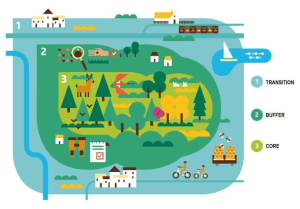TAG: GS 3: ECOLOGY AND ENVIRONMENT
THE CONTEXT: The province of Apayao in the Philippines has been declared a biosphere reserve by the United Nations, marking it as the fourth such site in the country.
EXPLANATION:
- This designation recognizes Apayao’s efforts in biodiversity conservation and sustainable development, highlighting the region’s unique ecological and cultural heritage.
The Significance of Apayao’s Biosphere Reserve Status
- Biosphere reserves are designated by the United Nations Educational, Scientific and Cultural Organization (UNESCO) as “learning places for sustainable development.”
- These areas are meant to promote solutions reconciling the conservation of biodiversity with its sustainable use.
- With Apayao’s inclusion, there are now a total of 759 biosphere reserve sites across 136 countries.
- Apayao joins the ranks of Albay, Palawan, and Puerto Galera as the Philippines’ biosphere reserves, showcasing the country’s commitment to preserving its natural landscapes and biodiversity.
Indigenous Conservation Practices
- At the core of Apayao’s recognition is the traditional practice of “lapat,” an indigenous system of forest conservation practiced by the Isnag people.
- Under this system, when an Isnag owner dies, a parcel of forest land and its natural resources are declared off-limits.
- This practice has significantly contributed to the preservation of the forest lands in Apayao.
- The Isnag people’s ethnic tradition of preserving forest lands makes Apayao one of the “learning places” around the world for biodiversity conservation.
- Their sustainable practices have been instrumental in maintaining the ecological balance in the region.
Ecological and Geographical Features
- The yApayaos Biosphere Reserve spans 3,960 square kilometers and encompasses the upper and lower regions of the province.
- The area is characterized by its peaks, plateaus, valleys, and the Apayao River, supporting a diverse range of flora and fauna.
- Apayao serves as a refuge for the critically endangered Philippine eagle (Pithecophaga jefferyi).
- The discovery of the first active nest of the national bird in the province in 2015 spurred local conservation efforts.
- Recently, a female Philippine eagle named Nariha Kabugao was released back into Apayao’s forest lands after successful rehabilitation.
Collaboration and Conservation Efforts
- The local government of Apayao has worked closely with various organizations such as the Philippine Eagle Foundation, the United States Forest Service, Forest Foundation Philippines, and San Roque Power Corporation to achieve the biosphere reserve status.
- These partnerships have been crucial in advancing conservation initiatives in the region.
- The recognition by UNESCO provides Apayao with international support and assistance in its conservation efforts.
- This acknowledgment is expected to enhance scientific research and improve living conditions for indigenous communities in the area.
Official Recognition and Future Prospects
- Apayao Governor led the Philippine delegation during the 36th session of the International Coordinating Council of the Man and Biosphere Programme of UNESCO in Agadir, Morocco, where the announcement was made.
- In his acceptance speech, Bulut highlighted the significance of this milestone for both Apayao and the Philippines.
- Other countries with newly declared biosphere reserves include Belgium, Gambia, Colombia, Dominican Republic, Italy, Mongolia, Netherlands, South Korea, Slovenia, and Spain.
- This global recognition underscores the importance of concerted efforts in biodiversity conservation amidst the challenges posed by climate disruption and the global biodiversity crisis.
Biosphere reserves
- Biosphere reserves are ‘learning places for sustainable development’.
- They are sites for testing interdisciplinary approaches to understanding and managing changes and interactions between social and ecological systems, including conflict prevention and management of biodiversity.
- They are places that provide local solutions to global challenges.
- Biosphere reserves include terrestrial, marine and coastal ecosystems.
- Each site promotes solutions reconciling the conservation of biodiversity with its sustainable use.
- Biosphere reserves are nominated by national governments and remain under the sovereign jurisdiction of the states where they are located.
- Biosphere Reserves are designated under the intergovernmental MAB Programme by the Director-General of UNESCO following the decisions of the MAB International Coordinating Council (MAB-ICC).
- Their status is internationally recognized. Member States can submit sites through the designation process.
These three functions are pursued through the Biosphere Reserves’ three main zones:
- Core areas (3)
- They comprise a strictly protected zone that contributes to the conservation of landscapes, ecosystems, species and genetic variation
- Buffer zones (2)
- They surround or adjoin the core area(s), and are used for activities compatible with sound ecological practices that can reinforce scientific research, monitoring, training and education.
- Transition area (1)
- The transition area is where communities foster socio-culturally and ecologically sustainable economic and human activities.

SOURCE: https://www.rappler.com/philippines/apayao-declared-biosphere-reserve-unesco-july-2024/
Spread the Word



